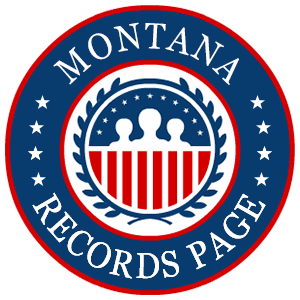Search for free Montana divorce records; these documents are available to the public under the state’s Public Records Act and the federal Freedom of Information Act (FOIA).
Accessing these records is important for many reasons, such as needing documentation to re-marry, researching ancestral lineages or even verifying a potential partner’s marital status.
Whatever the reason, interested persons can search for these records via state and county agencies — often at little to no cost. Residents also have a way to locate these records without knowing which county in Montana finalized the divorce; each method will be outlined below.
Are Divorce Records Public or Private in Montana?
Divorce records are in the public domain in Montana which means anyone can access and view this information. This is due to the Montana Public Records Act which makes records created by public bodies accessible to the general population.1
Nevertheless, these records become available for public consumption only when Montana’s Case Registry & Vital Statistics Reporting Form has been filed with the Clerk of the District Court that issued the decree.
While the public can view dissolution records to verify that the separation took place, they are not entitled to order certified copies of divorce certificates. They may only be requested by the parties to the records, immediate family members such as parents and children, and legal representatives authorized by the courts.
Interested parties can also turn to third-party vendors if they are unsure what county issued the divorce. These companies are typically not certified by the state and any copies they furnish cannot serve official purposes such as acquiring a name change.
Regardless of the accessibility of dissolution records, the U.S Census Bureau maintains divorce rates in the union—as of 2021, the state of Montana has a divorce rate of 8.3 per 1000 persons compared against the U.S. average of 6.9.2 In Montana, the trend has remained consistent having a variance of +/- 2.3% between 2011 and 2021. This census applies to all divorces and does not distinguish between conventional and same sex marriage.
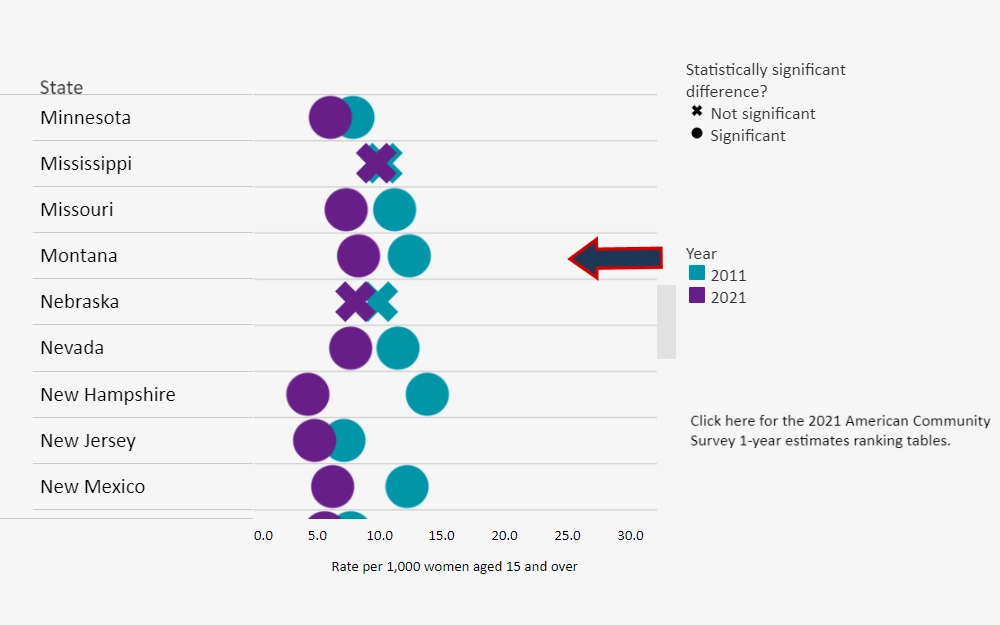
Additionally, the U.S. Census Bureau provides marital status of citizens by age, sex and race while also giving the approximate median age of men and women at the national level.
How To View & Obtain Free Montana Divorce Records
Patrons who need to view and obtain divorce records may do so at the county and state levels. At the state level, the Montana Department of Public Health & Human Services has records of divorces that have taken place in the state since July 1943.3
However, the state’s Vital Records Office does not issue certified copies of dissolution decrees; instead, it issues verification letters that the dissolution took place. Patrons may request these unofficial copies of dissolution records by mailing in an application to search divorce databases form.
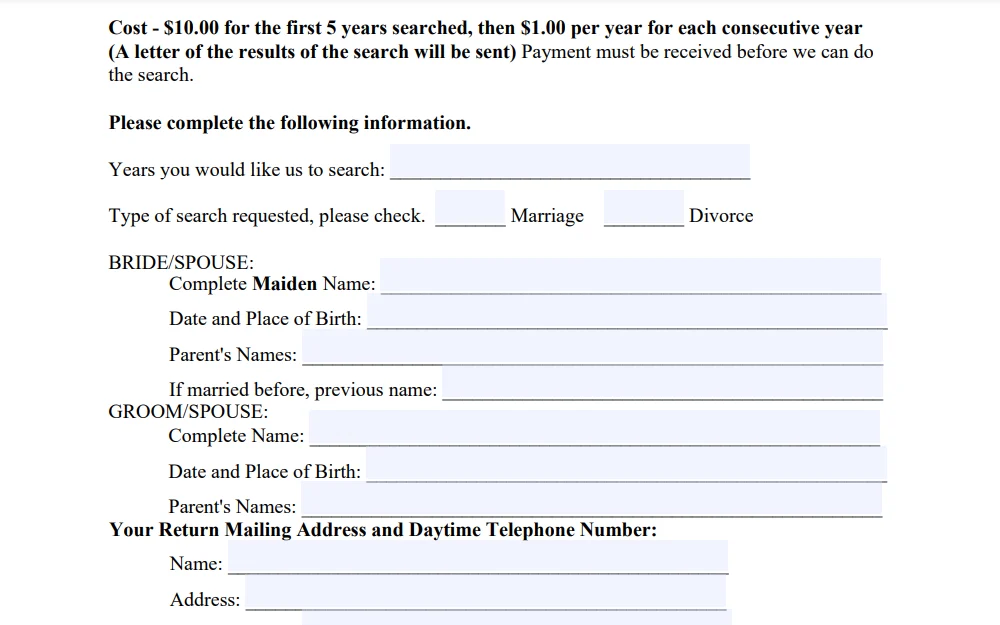
The Vital Records Office will charge $10.00 for the first five years of search and then levy $1.00 for every consecutive year thereafter. Searches are not run until payment is complete via check payable to the “Montana Vital Records.” The requestor will receive the verification letter detailing the search results.
Mail the request to the Montana Vital Statistics Office at the address below:
Montana Vital Statistics
111 North Sanders, Room 6
Post Office BOX 4210
Helena, MT 59604
Call 406.444.2685 or contact the Montana Vital Statistics Office with any questions.
Turning to Montana Counties & Cities for Divorce Records
Since letters of verification issued by the State Vital Records Office cannot be useful for official purposes such as adoption, name change or immigration requirements, interested parties must turn to the Clerk of the District Court in the county where the vital event was recorded.

Nevertheless, the State Vital Records Office permits a more comprehensive search since it includes records from all counties. Conversely, county offices are smaller and have staff more attentive to detail, orders from these offices are typically processed quicker.
This resource will use the three most populous counties in Montana to serve as an example on how to look for and request certificates of divorce—they are Yellowstone, Gallatin and Missoula Counties.
Order Divorce Records in Yellowstone County: Patrons can request certified copies of divorce records from the Yellowstone County Clerk of District Court.6 They may do so either by visiting the courthouse or mailing their requests. The Clerk imposes a mandatory $2.00 per name per year search fee for the first seven years and charges $1.00 for each additional year thereafter.
A copy of the decree of dissolution costs $10.00.
Visit the Yellowstone County Clerk of District Court at the courthouse address below Monday through Friday 8 AM to 5 PM with cash or a credit card. The office is on the 7th floor in rooms 702, 703 and 704.
Clerk of District Court
217 North 27th Street
Billings, Montana 59101
To mail in a request, include the case number and names on the record, state that a dissolution decree is being requested, include a copy of a government issued ID and a self-addressed envelope.
Search and copy fees must be paid in advance and included in the request—the requestor will pay via certified check or money order payable to the “Clerk of District Court.” Payments in credit card will require a credit card authorization form; a 2.5% bank fee applies.
To compute the exact payment amount, call 406.256.2869 or email [email protected]. Mail in the application to the Clerk of District Court address below:
Clerk of District Court
Post Office Box 35030
Billings, Montana 59107
Retrieve Dissolution Decrees in Gallatin County: Copies of divorce records are issued by the Gallatin County Clerk of District Court. Citizens can either obtain these by visiting the courthouse, mailing or calling in the request.
Gallatin County charges the same rate for searching for records as Yellowstone County; however, if the exact year of record is known, there is no search fee charge. Dissolution decrees cost $10.00 per copy and $12.00 for a certified copy. The applicant must make payment before any search proceeds.
To make a request by any other method, provide maiden name or name used at the time of divorce, date of divorce, type required (certified or simple copy) and payment. Payment can be made by credit/debit card or check.
If the requestor cannot make a determination to the total costs, leave the amount in the check blank. Include a phone number or address to allow the office to contact you.
Call 406.582.2157 or email [email protected] to make a request. Send written requests to the Gallatin County Clerk of District Court:
Gallatin County Clerk of District Court
Room 302, 615 South 16th Avenue
Bozeman, Montana 59715
Acquire Divorce Records From Missoula County: As with the other counties, the Missoula County Clerk of District Court makes available divorce records by fax, email or mail. Provide as much information as possible when requesting copies, such as names on the certificate and date of event.
This county has the same search rate as the previous two counties. Each copy of a divorce decree is $10.00 and an additional $2.00 applies for certification with a seal. Payments are made by check or credit card. Include a legible photocopy of a government issued ID such as a driver’s license.
Email [email protected] or fax the request to 406.258.4899. Include a self-addressed envelope for a mail-in order and send them to the Missoula County Clerk of District Court:
Missoula County Clerk of District Court
200 West Broadway
Missoula, Montana 59802
For other counties in Montana, consider using this syntax in a Google Search to obtain the correct source of dissolution information : “[county name] County divorce records search.”
In some instances, requestors may find divorce records through city agencies. Like counties, the three most populated cities will serve as an example on how to receive certified copies of divorce records. These three cities are Billings, Missoula and Great Falls.
Find Divorce Records in Billings: The City of Billings does not issue copies divorce records, but instead advises citizens to obtain them from the Yellowstone County Clerk of District Court. Please see the section above for the process to do this.
Retrieve Certificates of Divorces From Missoula: While the public can acquire data from the city such as municipal court records and police department information, the city of Missoula directs patrons to the county as Billings does. Interested parties will need to contact the Missoula County Clerk of District Court.
Search for Dissolution Decrees in Great Falls: Residents in Great Falls are advised to obtain divorce records from the county. They will need to contact the Cascade County Clerk of District Court.
To search for records from other towns and cities, use these keywords in a search engine such as Google: “[city name] divorce records search.”
Researching Family Genealogy & Lineage via Historical Divorce Records in Montana (Free)
Montana divorce documents are an integral part of a person’s genealogy and ancestral lineage research. There are several public agencies that patrons can contact to find this information—these include the county where the vital event occurred, the Montana Historical Society, the State’s Vital Office, libraries and newspapers.7
Finding these records can help interested persons locate their origins, ascertain financial assets held by ancestors and crucially, the names of their offspring.
Montana does not have a divorce index or archive but does have a historical society. The Montana Historical Society provides citizens with the ability to perform Research Requests. Interested parties have 30 minutes of reference time to run a free public divorce records search.

The staff may provide assistance for research that requires more time (up to two hours) for a $25.00 fee. Patrons are afforded 20 copies with this request; extra copies will incur a fee of $0.35 each. The address for the historical society appears below. Call 406.444.2694 for any questions.
Montana Historical Society
Post Office Box 201201
225 North Roberts
Helena, Montana 59620-1201
Archived divorce records prior to 1943 are at the Clerk of the District Court in the county where the decree was issued. Records created after 1943 can be found without identity restrictions at the Montana Department of Public Health and Human Services—data extrapolated from this state agency comes in the form of verification letters, and not certificates.
The Library of Congress has a collection of digitized Montana newspapers with some as early as 1871. They can be a source of divorce information as they may contain publications of dissolutions. This tool is free to use.
The Library also has an Online Catalog which interested parties can scour for divorce information at no cost. Additionally, citizens may contact public libraries in Montana that may have older divorce records.
Are Common Law Marriages & Divorces Recognized in the State of Montana?
Common law marriages are legal and recognized in Montana in spite of the couple not having solemnized the union with a wedding ceremony.9 This type of union does not come into being because a couple are living together, but only becomes a common law marriage when the couple intend to wed.
Three conditions must exist for this type of union: the couple must mutually consent to enter into a union, they must both be competent to marry and must cohabit and present themselves to society as a wedded couple.
Unlike many states where this type of union is recognized, in Montana, couples in common law marriages have a way to document their marital status. They do this by completing and signing an affidavit of common law marriage in the presence of a notary public.
As in other types of nuptials, common law marriages are deemed as real unions and are thus terminated either by death or by going through a formal dissolution process via the District Courts. These dissolution procedures also divide assets and have child custody resolutions as with regular marriages.
In 2004, Montana banned same sex marriages which are civil unions; however, this ban was repealed by a federal court judge who deemed the ban as a violation of the Equal Protection Clause of the 14th Amendment of the U.S. Constitution.10
As of 2014, Montana began issuing marriage licenses to same sex couples; therefore, applications for these types of marriage licenses are performed in the same way as other marriages.
How To Determine if Someone Had a Dissolution of Marriage or Is Common Law Divorced in MT
Interested parties can find a dissolution of a marriage or common law divorce record in the same way and that is either through state or county channels as outlined in the previous sections.
Patrons can locate these records by requesting a verification letter stating that the divorce took place whether common law or not from the Montana Department of Public Health & Human Services. The State’s Vital Records Office issues letters for events that occurred after 1943.
Alternatively, if the party requesting the record has a vested interest such as being a subject of the record, immediate family member or legal representative, they may acquire certificates of divorce from the Clerk of the District Court where the vital event was recorded. Counties in Montana maintain dissolution records recorded prior to 1943 to present.
Additionally, members of the public can turn to third-party vendors who will find divorce records from both types of unions for a fee. They are helpful especially if the requestor does not know where the record originated and which public agency holds custody of them.
How To Apply for a Divorce & Respond to Divorce Notices in Montana
Divorce is also known as dissolution of marriage in Montana and is the severing of marital ties, division of assets and settlement of child custody or support issues if applicable. Couples can petition for separation jointly or singly through the District Courts.
Partners who need to file for a divorce must have been residents for ninety days in Montana and the county where they wish to file. Having a ground for divorce is deemed a legal reason to get a dissolution and Montana, like many other states, has no fault grounds for obtaining a separation.
In Montana, joint or single dissolutions are filed with or without children and they are either contested or uncontested.11 The simplest dissolution process in the state known as a summary procedure is where there are no children or the wife is not pregnant and there is no disagreement as to the division of assets.
It is advisable to enlist the services of a lawyer particularly when the divorce is contested. The court provides dissolution information and instructions to help couples navigate the divorce procedure.
Uncontested Divorce: To initiate an uncontested divorce, the couple will file a Joint Petition for Dissolution With Children or a Joint Dissolution for Divorce Without Children. These links have the forms needed and instructions on the processes. If there are children involved, the couple are required to file a parenting plan—the court has an online questionnaire to help couples to find necessary forms for this.12
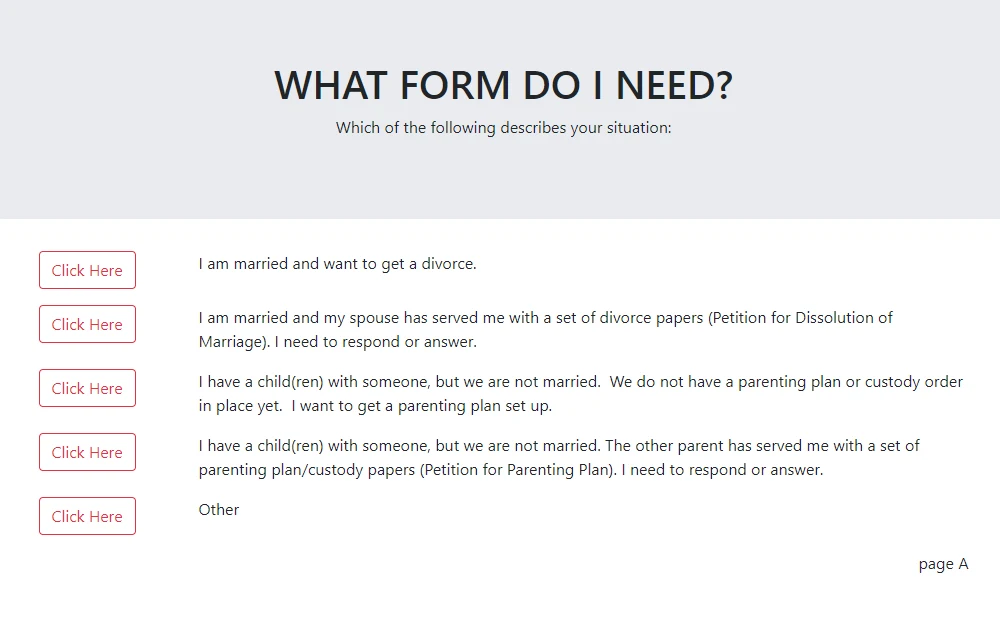
A dissolution with children process chart provides an overview of the undertaking. Filing costs for dissolution are on this fee schedule—the couple may request a fee waiver.
Divorces are finalized in hearings in court; however, in the case of an uncontested separation, the couple may avoid a hearing by filing an Affidavit for Entry of Decree for Dissolution of Marriage Without Hearing.
Without this affidavit, the couple will need to request a hearing date but an ex-wife or ex-husband may file a Consent to Entry of Decree and waive the right to appear. The judge will proceed to review the paperwork and sign the dissolution decree.
Contested Divorce: A contested divorce occurs when both parties do not agree to the division of assets, child custody or alimony. The applicant will file a Petition for Dissolution With Children or Petition for Dissolution Without Children.13 Additional forms are needed when the divorce is with children and the parties can query the forms they need in this scenario. Filing fees apply but can be waived.
Once the divorce papers are filed, the plaintiff (petitioner) must serve the papers to the defendant (former spouse) which may be done through the sheriff’s office, Notice of Acknowledgement in the case of a cooperative spouse, by publication or private process server.
The courts provide instructions on how to respond to a petition for dissolution or parenting plan. It is possible for the judge to require the plaintiff or defendant to attend a mediation before their dissolution or parenting plan case is heard in court.
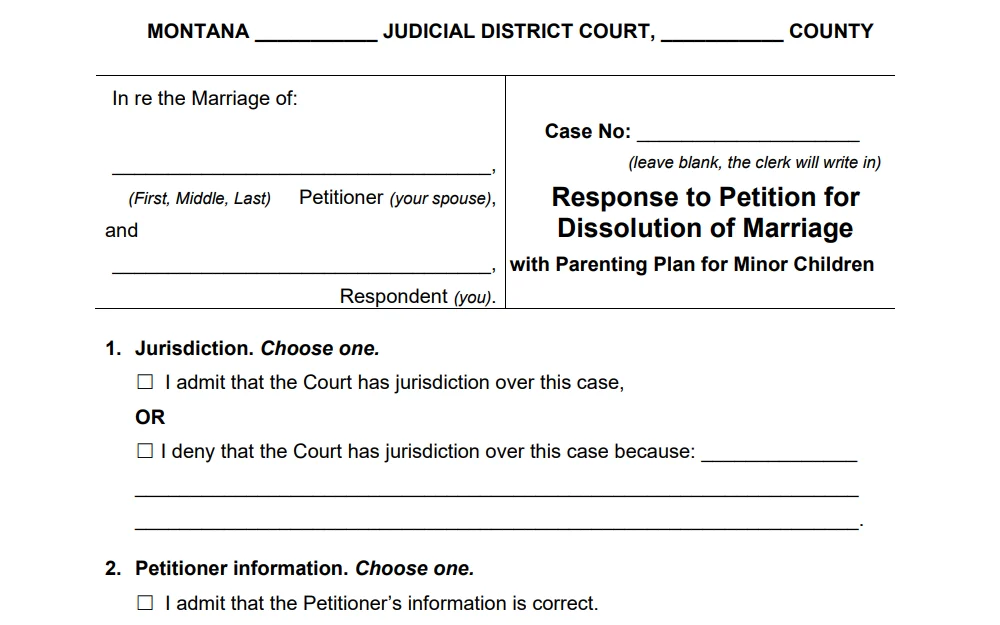
Both parties will attend the hearing after receiving a document known as a Scheduling Order. At the hearing, they will both present their evidence by taking the witness stand and the judge will review both sides of the argument before entering a ruling which will be mailed.
Members of the public can view Montana divorce records efficiently with the correct tools at their disposal, which can be found in this resource; they may use this information to obtain pertinent data for genealogy and ancestral lineage research.
If you’re wanting to find records of the initial marriages, the Montana marital lookup tutorial has streamlined guidance for you. If you’re seeking additional types of records — such as property ownership, background check reports, criminal histories, warrants, births, deaths, and more — check out the instructions for obtaining free public information in MT.
References
1Montana Legislature. (n.d.). Montana Code Annotated 2021. Retrieved November 9, 2023, from <https://leg.mt.gov/bills/mca/title_0020/chapter_0060/part_0100/sections_index.html>
2United States Census Bureau. (n.d.). U.S. Marriage and Divorce Rates by State: 2011 & 2021. Retrieved November 9, 2023, from <https://www.census.gov/library/visualizations/interactive/marriage-divorce-rates-by-state-2011-2021.html>
3Montana Department of Public Health and Human Services. (n.d.). Forms and Applications. Retrieved November 9, 2023, from <https://dphhs.mt.gov/vitalrecords/vitalrecordsforms>
4Montana Department of Public Health and Human Services. (2020, May). Application for Search of Marriage & Divorce Indexes. Retrieved November 9, 2023, from <https://dphhs.mt.gov/assets/Statistics/VitalStats/MDAPPW.pdf>
5Montana Judicial Branch. (n.d.). District Courts. Retrieved November 9, 2023, from <https://courts.mt.gov/courts/dcourt/>
6Yellowstone County Clerk of District Court. (n.d.). Searches and Copies. Retrieved November 9, 2023, from <https://www.yellowstonecountymt.gov/clerk_court/copies.asp>
7Montana Historical Society. (n.d.). Research. Retrieved November 9, 2023, from <https://mhs.mt.gov/research/>
8Montana Historical Society. (n.d.). Research Requests. Retrieved November 9, 2023, from <https://mhs.mt.gov/Research/ResearchRequests>
9Montana Legislature. (n.d.). Validity Of Common-Law Marriage. Retrieved November 9, 2023, from <https://leg.mt.gov/bills/mca/title_0400/chapter_0010/part_0040/section_0030/0400-0010-0040-0030.html>
10National Archives. (n.d.). 14th Amendment to the U.S. Constitution: Civil Rights (1868). Retrieved November 9, 2023, from <https://www.archives.gov/milestone-documents/14th-amendment>
11Montana Judicial Branch. (n.d.). Divorce, Dissolution, Legal Separation, Annulment. Retrieved November 9, 2023, from <https://courts.mt.gov/forms/end_marriage>
12Montana Judicial Branch. (n.d.). What Form Do I Need? Retrieved November 9, 2023, from <https://courts.mt.gov/external/library/marriage/default>
13Montana Judicial Branch. (n.d.). Dissolution with Children. Retrieved November 9, 2023, from <https://courts.mt.gov/forms/Dissolution/kid>
14Montana Judicial Branch. (n.d.). How to File a Response to a Petition for Dissolution of Marriage or a Petition for Parenting Plan. Retrieved November 9, 2023, from <https://courts.mt.gov/external/forms/dissolution/diskids-reponse-packet.pdf>
